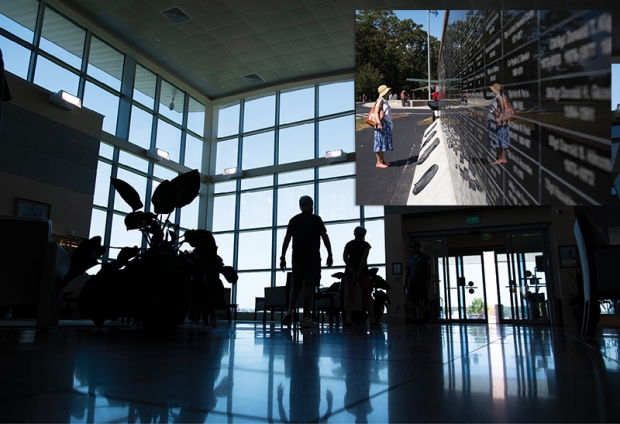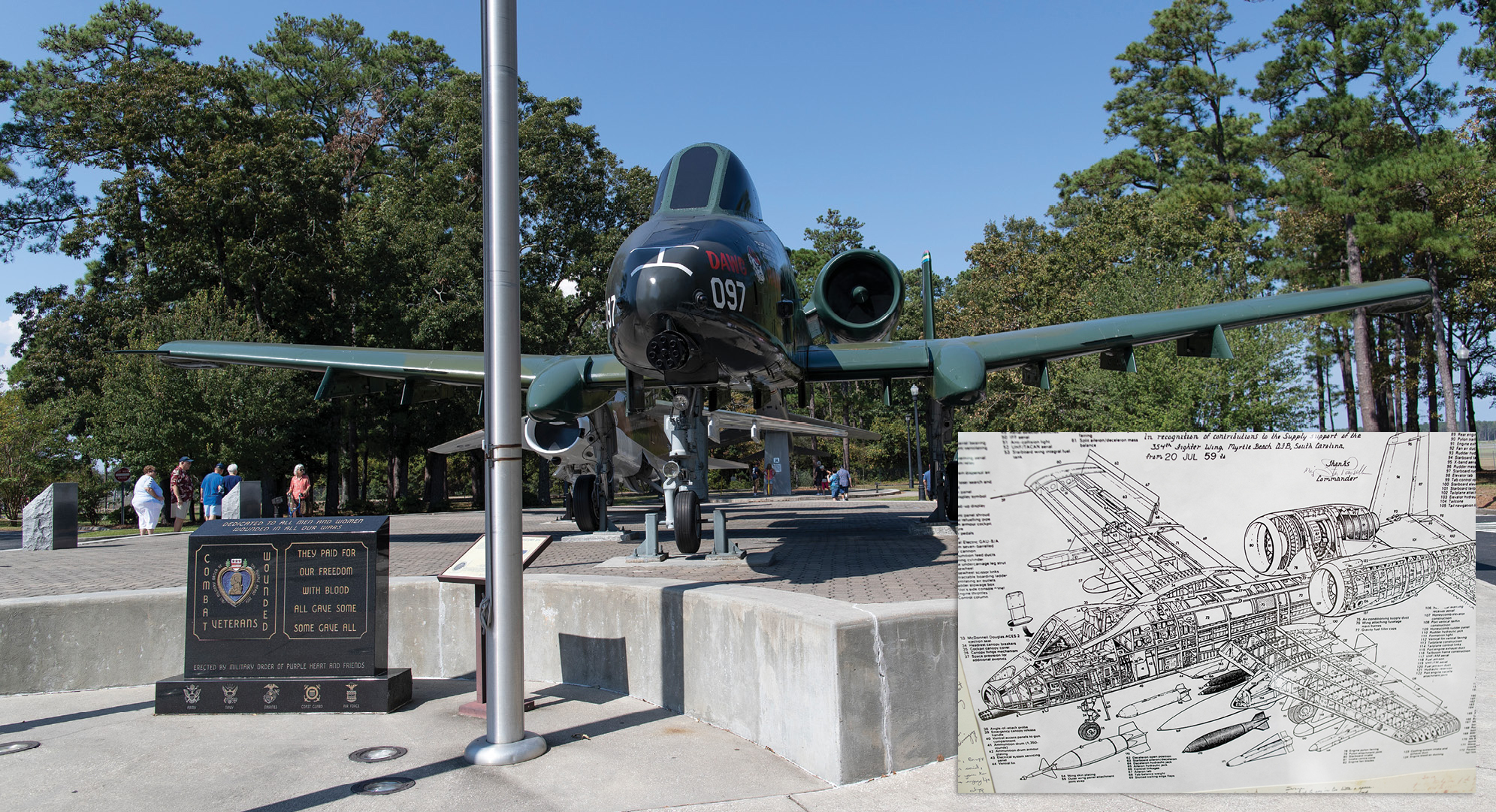Exploring the rich military history of Myrtle Beach

When you walk the tree-lined streets of The Market Common, you’re walking hallowed ground rich in the history of our armed forces. Take the time to read some of the many plaques along the sidewalks the next time you’re heading to the movies, a restaurant or shopping and you will get a flavor for the enormous impact our uniformed men and women had on this area. Better yet, take the Military History Tour run by The Market Common from September through April and learn about the Myrtle Beach Air Force Base and its vital role in our nation’s history.
This history begins in the late 1930s when Myrtle Beach civic leaders began funding and planning for a municipal airport. Very soon, federal funding was employed and the U.S. War Department added acreage and continued the planning, including adding an Army air base to the plans. This was before the U.S. Air Force was even created, which happened in 1947.
The area saw tremendous activity during World War II. Members of the Royal Netherlands Military Flying School trained here, as well as several Americans who took part in Lt. Col. James Doolittle’s famous raid on Tokyo in 1942. In April 1944, President Franklin D. Roosevelt visited the base while he was on a month-long visit with his friend and advisor Bernard Baruch, at Hobcaw Barony just south of Myrtle Beach. While here, FDR put the finishing touch on the enormous plans for the Allies’ D-Day invasion of Normandy, which would ultimately lead to victory in Europe.
More than 600 German prisoners of war were housed here during WWII. They performed certain duties on the base as well as on local farms where they picked crops, tended fields and livestock, and cut timber. These POWs were treated so well that, after the war and their release back to Germany, several returned to the Grand Strand and started families whose descendants still live here today.
The Myrtle Beach Air Force Base was officially founded in 1954 and proved to be extremely important throughout the Cold War, the Vietnam conflict and Desert Storm. At its peak, it consisted of 4,000 acres, 2,800 active duty personnel and 800 civilian employees. It served as a training base for fighters and bombers and was home to three squadrons of A10 fighters—the “ugly duckling” that has become the hero of our fighting men and women on the ground because of its durability and supporting firepower.
Seagate Village, which still exists as private real estate along U.S. 17 Business and Farrow Parkway, provided 800 family housing units. After the base closed, the Myrtle Beach Air Force Base Redevelopment Authority purchased Seagate Village from the Air Force in 1997 and leased them to a local developer, who bought all the housing units in 2001 and slowly sold them to individual owners. Today, they are all privately owned.
The first base commander was Col. Robert G. Emmens. He had participated in Doolittle’s raid on Tokyo in 1942. After bombing Tokyo, his B-25 bomber made it to Russia, where he was held captive for 13 months before escaping through Persia. In 1955, he was assigned to command the new 4434th Air Base Squadron, tasked with supervising the rehabilitation and construction of the Myrtle Beach Air Force Base.
When the base opened officially in 1956, a new commander was assigned—Col. Francis S. Gabreski—a true American warrior. Gabreski was raised in Oil City, Pennsylvania, by a Polish American family and spoke fluent Polish. During WWII, he survived the attack on Pearl Harbor. He then transferred to Europe, where he helped train and command Polish pilots flying with the British Royal Air Force. He became America’s greatest flying ace, destroying 26 enemy aircraft, surpassing the famous Eddie Rickenbacker. He was shot down and taken prisoner in July 1944 but survived the ordeal and later served combat duty in Korea.
The base’s former recreation center and the avenue it is on are named in Gabreski’s memory. The rec center remains active today as a city facility for numerous recreational and educational activities.
The base continued to serve important roles throughout the Cold War, Vietnam and Desert Storm. Three of the strategic planes that called Myrtle Beach home were the A10 Warthog, mentioned earlier, the F-100 Super Sabre and the A-7 Corsair II. All three of these planes are on display at War Bird Park along Farrow Parkway.

During Desert Storm, two squadrons of A10s and their support group, approximately 55 planes, flew from Myrtle Beach to Saudi Arabia. The pilots had to refuel in midair over the Atlantic and Mediterranean numerous times before arriving to take part in the combat.
Col. Joe Barton was Operations Officer of the 355th Tactical Fighter Squadron (TFS), one of the two squadrons from here. The other was the 353rd TFS. Today, he is retired and living in Myrtle Beach. “I told every man and woman under my command that the best assignment you will ever have in the Air Force is Myrtle Beach,” said Barton.
Barton, a graduate of the University of Georgia and proud fan of the Bulldogs, first came to Myrtle Beach in 1970 for ROTC summer camp. He also trained in Valdosta, Georgia, and was a flight instructor in Tucson, Arizona, where he first flew the A10. The actual plane he flew in Desert Storm is the A10 on display at War Bird Park—a stop on The Market Common tour. Look for his Georgia Bulldog painted on the side of the cockpit.
“The A10 proved to be a formidable weapon to help our soldiers on the ground,” remarked Barton. “We lost only two planes in combat during Desert Storm, and we proved the A10 could fly combat missions at night. Today, the Air Force still utilizes the A10 with advanced technological equipment like night vision and GPS.”
The Myrtle Beach Air Force Base closed officially in March 1993. Colonel Barton and his family were among the last families to move off base.
Col. Buddy Styers is another Air Force hero and is the driving force behind what The Market Common has become. Styers grew up visiting Myrtle Beach, and in 1954 his father bought a motel and moved the family here. Styers joined the Air Force in 1966 and had a stellar 26-year career, but oddly was never stationed at Myrtle Beach. After retiring here from the Air Force where he had commanded two different bases, he became Executive Director of the Air Force Base Redevelopment Authority.
Styers and his board adopted an “urban village” development plan, a model they had seen achieve success elsewhere, and the results have been spectacular.
“I knew that eventually the area would look nothing like it once was,” Styers remarked. “So I made a strong effort to preserve the history of what the air base had been and what it had contributed.”
Today, many of the streets in The Market Common are named for people who served at the base. Also, the neighborhood has numerous plaques honoring those who served and describing their contributions and service accomplishments. The plaques can be seen at several places around The Market Common near the shops, restaurants and residential units.
Styers and his board also went to great lengths to preserve and re-purpose many of the buildings and facilities. The former recreation center has been converted into an all-purpose recreational/educational/social center for the city. The base housing, as mentioned earlier, has become a beautiful little beach neighborhood of privately owned units. Other buildings and facilities have been converted for private aviation and commercial business enterprises, creating jobs and enhancing the local tax base.
So the next time you shop, dine or go to a movie at The Market Common, take a moment to reflect on its rich history and to quietly honor the military men and women who served so honorably there.
MILITARY HISTORY TROLLEY TOUR INFO
Tickets are available September through April at eventbrite.com. Tours, taken on a comfortable trolley, run on Fridays twice monthly in January, February and March, and once in April. Tours are $30 per person and begin in front of the Stone Theatre and end at Tupelo Honey. The trolley tour is approximately one hour, followed by refreshments and an extremely interesting one-hour slide presentation by a retired U.S. Air Force colonel. For more information contact The Market Common’s Management Office at (843) 839-3500.
Tour highlights:
Base recreation center
Base housing complex
War Bird Park
Valor Park
Original air terminal/private aviation center
Historical markers
In addition to the traditional Military History Tour, two new tours are on the 2020 schedule, taking place each Tuesday afternoon at 2 p.m. through March. On the first and third Tuesdays will be the Early Myrtle Beach & The War Years Tour. This tour will make stops at Pine Lakes Country Club and the H.B. Springs Building, while riders learn about Myrtle Beach’s earliest years and what it was like during WWII, 1941–1945, with U-boat threats off the coast and the arrival of German POWs. The second and fourth Tuesdays will be for more general history buffs with an entertainment leaning, the Myrtle Beach History, Movies & Music Tour. This tour will make stops at Jack Thompson’s gallery and the history of music, from beach to country, will be discussed.